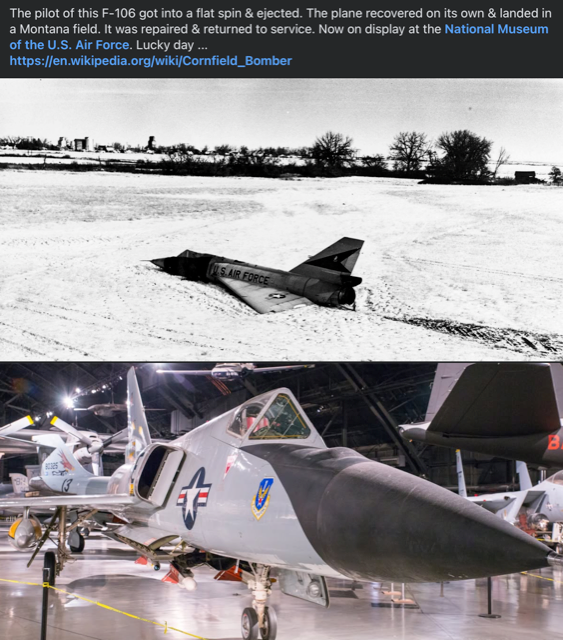Mildly interesting
-

During a routine training flight conducting aerial combat maneuvers on February 2, 1970, the aircraft entered a flat spin. The pilot, First Lieutenant Gary Foust,[2][3] deployed the aircraft's drag chute as a last resort while attempting to recover.[2] When it failed Foust ejected at an altitude of 15,000 feet (4,600 m).[4]
The reduction in weight and change in center of gravity caused by the removal of the pilot,[5] coupled with the blast force of his seat rocketing out of the plane pushing the nose of the aircraft down, which had been trimmed by Foust for takeoff and idle throttle, caused the aircraft to recover from the spin. The previously set trim then helped stabilize the attitude of the plane after the initial nose down.[5] One of the other pilots on the mission was reported to have radioed Foust during his descent by parachute that "you'd better get back in it!"[2] From his parachute, Foust watched incredulously as the now-pilotless aircraft descended and skidded to a halt in a farmer's field near Big Sandy, Montana.[5] Foust drifted into the nearby mountains. He was later rescued by local residents on snowmobiles.[2][4]
Shortly thereafter, the local sheriff and local residents arrived at the scene of the crash. The thrust from the still-idling jet engine allowed the aircraft to slowly drift on its belly across the field after it landed.[3] The sheriff, having contacted the air base, was informed that he should simply allow the jet to run out of fuel, which occurred one hour and 45 minutes later without further incident.[2] A recovery crew from McClellan Air Force Base arrived on the scene and began to dismantle the aircraft, removing its wings for transport aboard a railroad flat car. The damage to the aircraft was minimal; indeed, one officer on the recovery crew is reported to have stated: If there were any less damage, he would have simply flown the aircraft out of the field.[2][4]
-
Catgut suture is a type of absorbable surgical suture traditionally made from the natural fibers of animal intestines, primarily the submucosal layer of sheep or goat intestines. Despite its name, it is not made from the intestines of cats.
Key Features of Catgut Sutures:
1 Absorbable:- Catgut sutures are gradually broken down and absorbed by the body over time through enzymatic action. This eliminates the need for suture removal.
2 Types:
- Plain Catgut: Absorbed relatively quickly, typically within 7–10 days.
- Chromic Catgut: Treated with chromium salts to delay absorption and increase durability. Lasts approximately 21–28 days.
3 Uses:
- Commonly used in soft tissue approximation, ligation, and surgeries where long-term tensile strength is not required.
- Often used in gynecological, gastrointestinal, and pediatric procedures.
4 Advantages:
- Biodegradable and absorbed naturally.
- Minimizes the need for follow-up removal surgeries.
5 Disadvantages:
- Can cause an inflammatory reaction in some individuals due to its natural origin.
- Loses tensile strength relatively quickly.
- Sterility and uniformity can be less predictable compared to synthetic sutures.
Today, catgut sutures are less commonly used due to the availability of synthetic alternatives, like polyglactin (Vicryl) or polyglycolic acid sutures, which offer more consistent performance and fewer risks of tissue reaction.
-
What Is the Origin of the Saying "Spick and Span"?
The term spick and span means brand new. This term has a nautical origin. Spick meant nails (or spike) and span meant wooden shavings. On a new sailing ship, the nails would still be shiny and the wooden shavings from manufacture would still be present. Therefore, a new ship would be all spick and span.

